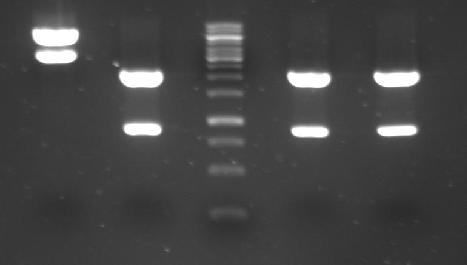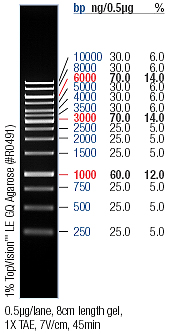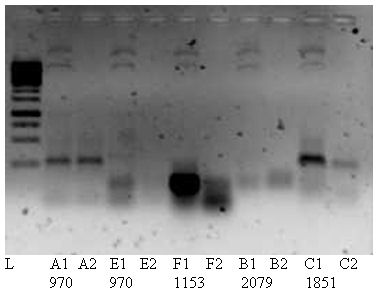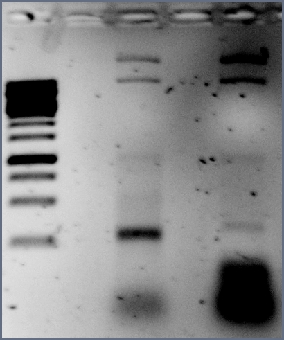Team:Groningen/Notebook/17 July 2009
From 2009.igem.org
Wet
GVP Cluster
Discussion:
All colonies (transformants vector + promoter ligated with gvp) and o/n culture became red, so probably RFP is still in there... What might be the problem? The vector with promoter self-ligated due to uncomplete digestion (done 15 July 2009) leading to the following fragments:
- vector+RFP linear
- vector
- RFP
When the upper fragment (~2kb) is contaminated with linear vector this would lead high efficiency self-ligation instead of ligating gvp with the emtpy vector.
- →TODO Therefore the restriction/purification/ligation will be redone and selection of non-red colonies will be made!
- →DONE Also plasmid from the o/n cultures will be purified and analysed by restriction analysis.
- For plasmid isolation the Sigma Plasmid isolation kit was used (eluted in 50ul MQ).
- DNA concentrations:
| Sample | ng/ul | 260/280 | 260/230 |
| gpv-promoter test (colony 9) | 82.5 | 2.02 | 2.21 |
| gpv-promoter test (colony 10) | 71.9 | 1.96 | 2.21 |
- Restriction analysis with SpeI and PstI to find insert length.
- Expected length of with / with RFP insert: 2096bp(promoter + plasmid backbone), 887bp(RFP)
- Expected length of with gvp insert: 2096bp(promoter + plasmid backbone),6096bp(gvp)
- Expected length of with gpv insert: 3513(plasmid backbone), 6096 (GVP cluster)
Restriction mixture for J23100+gvp and GVP
- 10 μL promoter plasmid (61.4 ng/μL, 96.1 ng/μL)
- 6μL MQ
- 2μL Fast digest buffer
- 1μL PstI fast digest enzyme
- 1μL SpeI fast digest enzyme
10ul was loaded on a 1%TBE agarose gel and ran for 30 @ 100V (V const)
- →From left to right: 1kb marker, gvp-promoter () construct nr 9, nr 10, gvp in , promoter ()
So the assumption that the vector with the promoter self-ligated was right, as the gvp-promoter construct has the same bands as the promoter has and the size of the bands are as expected for a RFP insert.
Restriction of GVP and J23109/106/100 for ligation of promoter (+ backbone) and the GVP cluster
To create a plasmid containing the promoters BBa_J23109, BBa_J23100 and BBa_J23106, and the GVP cluster the GVP cluster is cut out of its vector and the RFP is cut out of the vector containing the promoter.
Mix for GVP:
- 2 μl fast digest buffer
- 6 μl plasmid (329,7 ng/μl)
- 1 μl PstI (fast digest)
- 1 μl XbaI (fast digest)
- 10 μl MQ
Mix for J23:
- 2 μl fast digest buffer
- 1 μl PstI (fast digest)
- 1 μl SpeI (fast digest)
- 109:
- 11 μl plasmid (174.9 ng/μl)
- 5 μl MQ
- 106:
- 8.5 μl plasmid (219.4 ng/μl)
- 7.5 μl MQ
- 100:
- 11 μl plasmid (155.3 ng/μl)
- 5 μl MQ
Incubation 37°C for 1h.
Purification of restriction fragments on gel
- 1% SBA gel, run 35 min at 100V
- Gel result:

- The bands at ~6kb, which corresponds to the GVP cluster, and the bands at ~2kb (for the promoter lanes), containing the promoter + backbone fragment, are excised.
Purification of the restriction fragments, 6kb GVP cluster and 2 kb promoter-backbone fragment, from the Agarose
Purification is performed with the High pure PCR product purification kit (Roche).
- 300 μL Binding buffer added for every 100 mg agarose
- vortexed 30 s
- 45 min in 64°C to dissolve the agarose(vortexed every 5 min)
- 150 μL isopropanol added for every 100 mg of agarose
- vortexed 15 s
- Contents pipetted into a filter tube
- Centrifugation 60 s max speed (14600 rpm), flowthrough is discarded
- 500 μL Wash buffer added, centrifugation 60 s max speed, flowthrough is discarded
- 200 μL Wash buffer added, centrifugation 60 s max speed, flowthrough is discarded
- 50 μL MQ added, centrifugation 60 s max speed
- Flowthrough contains the product DNA
- The flowtrough without the filtertube is centrifuged (2 min, 14600rpm)
Concentrations of J23109/100/106 and GVP
BBa_J23109 eluted in MQ
- 13.1 ng/μL
- 2.67 (260/280)
- 1.09 (260/230)
BBa_J23100 eluted in MQ
- 11.9 ng/μL
- 1.90 (260/280)
- 0.81 (260/230)
BBa_J23106 eluted in MQ
- 11.1 ng/μL
- 2.10 (260/280)
- 0.73 (260/230)
GVP eluted in MQ
- 12.1 ng/μL
- 2.25 (260/280)
- 0.56 (260/230)
Transporters
Below yesterdays PCRs, There seems to be a vague band at ~1000 in A1 and E1. therefore loaded the last 20 uL PCR Product on gel as well. showing an expected product op 970bp.
Because of the negative results we will try to get positive results with an other polymerase enzyme; Phusion. And try the cloning again as planned. PCR1 Fw,mut1RC should give product of 1153bp and PCR2 Rev,mut2RC a 261bp size product. Further more we will test a PCR with pBAD 24 Fw,rev to test the template and look at options to get smaller templates (2222 bp).
|
|
|
|
|
|
Metal Accumulation
Vectors
- inactivated ligation of vectors with promotors: 10 min at 70°
Transform vectors pSB1AC3 and pSB3K3 with promotors J23100, J23106 and J23109 to Top 10 cells
- add 5 ul ligation mixture to E.coli top 10 from -80°
- incubate 30 min on ice
- heat shock 5 min at 37°
- 5 min on ice and add to 1 ml TY
- incubate for 1 hour at 37° with shaking
- concentrate (max. rpm for 1 min)
- plate 200ul of cells on plates
- 8 plates
- - top10-pSB1AC3 + promotor J23100 on TY plate resistance amp+cam
- - top10-pSB1AC3 + promotor J23106 on TY plate resistance amp+cam
- - top10-pSB1AC3 + promotor J23109 on TY plate resistance amp+cam
- - top10-pSB1AC3 + promotor J23100 on TY plate resistance kan
- - top10-pSB1AC3 + promotor J23106 on TY plate resistance kan
- - top10-pSB1AC3 + promotor J23109 on TY plate resistance kan
- - top10-H2O on TY plate resistance amp+cam
- - top10-H2O on TY plate resistance kan
| plate | colonien |
|---|---|
| psb1AC3 109 | 8 |
| psb1AC3 100 | 2 |
| psb1AC3 106 | 10 |
| psb3K3 109 | 5 |
| psb3K3 100 | 9 |
| psb3K3 106 | 3 |
Dry
We mostly tried to find other/better software to use instead of Matlab. In simbiology you are able to export a model using SBML. At the SBML (Systems Biology Markup Language) website if you click on SBML Software Guide and then choose SBML Software Matrix you get a table of all sorts of modelingprograms. It specifies what each program does and in what manner it is compatible with SBML. Specifically we looked at: VCell, Tinkercell and Cytoscape. Although they all claim to be compatible with SBML we had trouble loading our model in VCell and Tinkercell. Cytoscape was able to load our model, but it is in its core stronger in analyzing networks then running simulations.
Furthermore we tried to get SEMPPR (also see Gilchrist2007) to work. We failed under Windows, but succeeded after recompiling it under Linux without -static. We still have to figure out exactly how to interpret the results though (in any case, the production rates only apply to the translation step), to which end I (Jasper) have started a list of concepts on the modelling page.
Also, in an attempt to figure out how to interpret the protein production rates Jasper concluded that the units in Beyer2004 seem to be inconsistent. Specifically, it is unclear what the units of kp, ktransl,i and PHD are:
- It is suggested that PHD mathematically has units of time in the second paragraph below equation 1.
- In the caption of figure 1 it is mentioned that PHD is PRR divided by the translation rate, since PRR is a ratio the translation rate should have units of 1/time (which sounds logical).
- If kd,i necessarily has units of 1/time, PHD = kp/kd,i and PHD indeed has units of time, then kp should have no/arbitrary units (even though the description says that it "essentially ... quantifies the speed of elongation").
- If kp has no units ktransl,i has to have units of 1/time. However, ktransl,i (and/or the translation rate) is defined as "the product of ribosome density and ribosome occupancy", neither of which has anything to do with time... (Ribosome density is defined as "ribosomes per transcript length" and ribosome occupancy as "fraction of mRNA bound to ribosomes".)
Interestingly Gilchrist2007 mentions that Beyer2004 determines the translation rate per mRNA by multiplying the ribosome occupancy by 10 amino acids/sec.
|
|
|
| |||||||||||||||||||||||||||||||||||||||||||||||||||||||||||||||||||||||||||||||||||||||||||||||||||||||||||||||||||||||||||||||||||||||||||||||||||||||||||||||||||||||||||||||||||||||||||||||||
|
|
|
| |||||||||||||||||||||||||||||||||||||||||||||||||||||||||||||||||||||||||||||||||||||||||||||||||||||||||||||||||||||||||||||||||||||||||||||||||||||||||||||||||||||||||||||||||||||||||||||||||
 "
"




